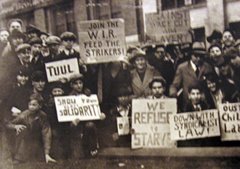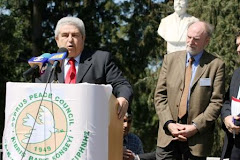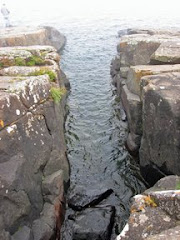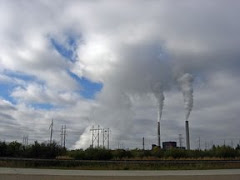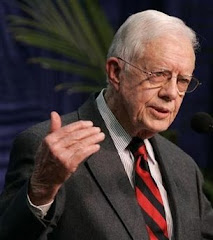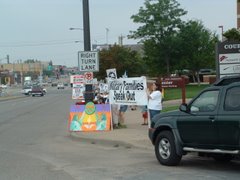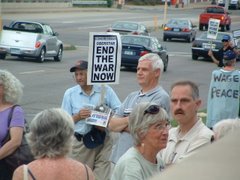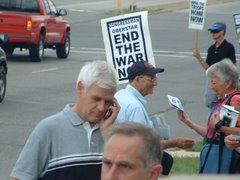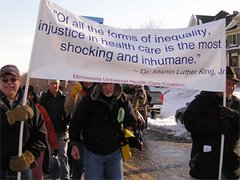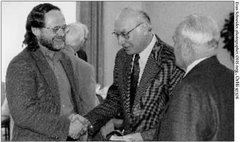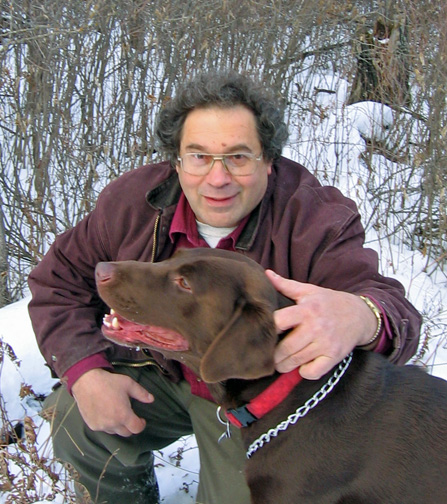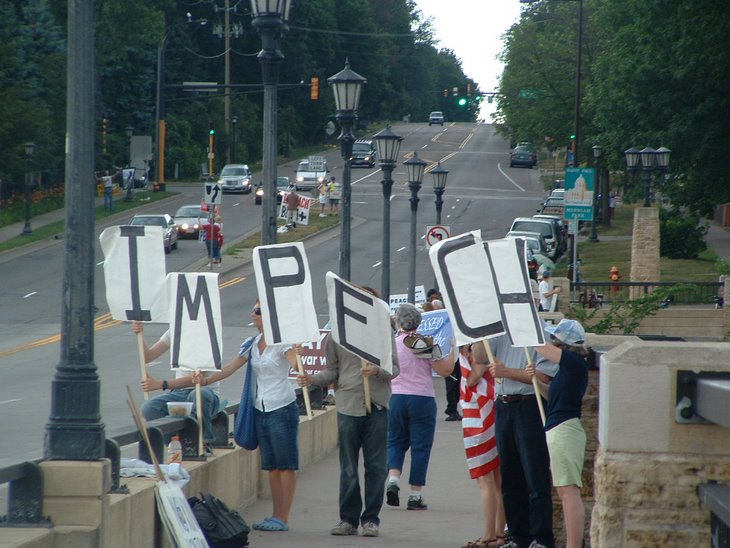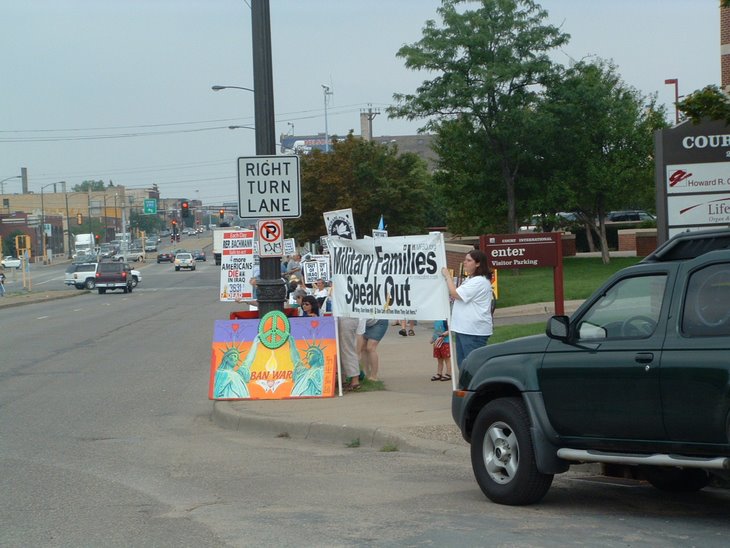Nuclear denial: From Hiroshima to Fukushima
Abstract
Governments and the nuclear power industry
have a strong interest in playing down the harmful effects of radiation
from atomic
weapons and nuclear power plants. Over the years,
some scientists have supported the view that low levels of radiation are
not harmful, while other scientists have held that
all radiation is harmful. The author examines the radiation effects of
nuclear bombs dropped on Japan in 1945; nuclear
weapons testing; plutonium plant accidents at Windscale in England and
Chelyabinsk
in the Soviet Union; nuclear power plant emissions
during normal operations; and the power plant accidents at Three Mile
Island
in the United States, Chernobyl in the Soviet
Union, and Fukushima Daiichi in Japan. In each case, he finds a pattern
of minimizing
the damage to humans and attributing evidence of
shortened life spans mostly to stress and social dislocation rather than
to radiation. While low-level radiation is now
generally accepted as harmful, its effects are deemed to be so small
that they
cannot be distinguished from the much greater
effects of stress and social dislocation. Thus, some scientists declare
that
there is no point in even studying the populations
exposed to the radioactive elements released into the atmosphere during
the 2011 accident at Fukushima.
The Fukushima Daiichi nuclear disaster, which
began in March 2011, is unique in many respects: the massive tsunami,
the multiple
reactor meltdowns, the rats gnawing through
switchboards, the struggle to contain huge amounts of radioactive water.
But when
it comes to the human health impacts of the ongoing
emergency in Japan, it’s déjà vu all over again, as Yogi Berra would
say.
Fukushima is an eerie replay of the denial and
controversy that began with the atomic bombings of Hiroshima and
Nagasaki.
The 2011 headlines differ little from those that
appeared in 1945: “Survey Rules Out Nagasaki Dangers” then, and “Experts
Foresee No Detectable Health Impact from Fukushima
Radiation” now (
Greene, 2012;
Revkin, 2013).
This is the same nuclear denial that also greeted nuclear bomb tests,
plutonium plant disasters at Windscale in northern
England and Chelyabinsk in the Ural Mountains, and the
nuclear power plant accidents at Three Mile Island in the United States
and Chernobyl in what is now Ukraine.
Today, the scientific community remains
divided over the effects of low-level radiation, with a significant
minority of experts
holding that low levels are essentially harmless,
while the majority says that all levels are harmful to some degree (
Beyea, 2012). Estimates of how many people will die as a result of radiation released from Fukushima range from none (
UNSCEAR, 2013) to 1,400 people developing cancer as a result of just the first year of exposure to fallout in the contaminated regions
outside the evacuation zone (
Rosen, 2012).
The Fukushima disagreement is only the latest
chapter in a 68-year-old story. Although it may seem that the two
scientific
camps are not far apart, the question of whether there
is any threshold for radiation impacts is a critical one. Unlike the
climate debate, nuclear “deniers” are not a tiny
minority but rather are respected members of the scientific community
who
specialize in radiation effects. Most of these experts
no longer contend that there is zero harm in low-level radiation, but
rather that the range of uncertainty includes zero: In
other words, low-level health effects may exist, but they are too small
to measure. This view preserves the status quo, since
there is no point in comprehensively measuring low-level radiation
effects
or taking aggressive steps to prevent harm. Nuclear
denial creates scientific ambiguity that provides cover for governmental
and commercial interests and allows nuclear power to
continue expanding worldwide.
Fukushima’s health effects
Soon after the Fukushima Daiichi disaster
began, industry organizations, governments, and international agencies
declared
that there were not likely to be any long-term
radiation dangers. One of the first was a spokesperson for the Nuclear
Energy
Institute, a nuclear energy trade group, who
declared three months after the accident that “no health effects are
expected
among the Japanese people as a result of the events
at Fukushima” (
Nuclear Energy Institute, 2011).
The World Health Organization was also
reassuring, stating that while people worldwide receive about 3
millisieverts of radiation
per year from sources including background
radiation and medical procedures, only two Japanese communities had
effective dose
rates of 10 to 50 millisieverts, a bit higher than
normal.
1 The rest of the Fukushima prefecture and neighboring prefectures were below 10 millisieverts (
Brumfiel, 2012;
World Health Organization, 2012b).
Experts convened in Vienna by the United
Nations Scientific Committee on the Effects of Atomic Radiation
concluded: “Radiation
exposure following the nuclear accident at
Fukushima-Daiichi did not cause any immediate health effects. It is
unlikely to
be able to attribute any health effects in the
future among the general public and the vast majority of workers” (
UNSCEAR, 2013).
A public health study at Fukushima Medical
University reported that only 0.7 percent of people exposed received
doses above
10 millisieverts in the first four months after the
accident, and that the highest recorded dose was 23 millisieverts, well
below the 100-millisievert exposure level at which
the World Health Organization estimates a slight increase in cancer risk
(
Brumfiel and Fuyuno, 2012).
An article in
Scientific American (republished in
Nature)
saw no health effects from radiation and was positively jolly. While
one expert quoted in the article said that victims
could no longer get the usual treatments for their
conditions because of disruptions in the health system, he also said
they
“are probably getting better care than they were
before” the accident (
Harmon, 2012).
Other studies, however, have raised
considerable alarm. German pediatrician Alex Rosen examined reports from
Japanese agencies
that came to quite different conclusions than US
and international agencies such as the World Health Organization. One
example,
from the Japanese Ministry of Education, Culture,
Sports, Science and Technology (MEXT), indicated that a child living in
Iitate (a village in Fukushima prefecture) and
spending about eight hours a day outside would be exposed to about 148
millisieverts
during the course of a year—100 times the natural
background radiation in Japan of 1.48 millisieverts per year (
Rosen, 2012).
Medical checks by the Minami-Soma
municipal hospital using whole-body counters reportedly found that more
than half of the
527 children examined during and after September
2011 had internal exposure to cesium-137, one of the isotopes that pose
the
greatest risk to human health following nuclear
accidents (
Sentaku, 2012).
The French Institute for Radiological
Protection and Nuclear Safety (IRSN) also tells an alarming story. The
institute found
areas with ambient dose rates 20 to 40 times higher
than natural background radiation, and in the most contaminated areas
the rates were 10 times those elevated dose rates (
IRSN, 2012:).
While the World Health Organization report found just two communities
with doses of 10 to 50 millisieverts, IRSN found
places in four municipalities where doses could
have been higher than 25 millisieverts, and noted this was without
counting
plume exposure or consumption of contaminated
foodstuffs (
IRSN, 2012).
Contamination at levels above 50 millisieverts could have occurred as far as 60 kilometers south of the power plant (
IRSN, 2012). Close to 70,000 people living outside the evacuation zone were likely to receive a dose greater than 10 millisieverts in
the first year, the report said (
IRSN, 2012).
Nuclear physicist Frank N. von Hippel initially estimated 1,000 extra cancer deaths from radiation by extrapolating from an
estimate of 16,000 cancer deaths caused by Chernobyl (
von Hippel, 2011). More recently, von Hippel and others have estimated from 1,000 to 3,000 cancer deaths (
Beyea et al., 2013;
Fairlie, 2013).
Nuclear bomb fallout
Contradictory messages about radiation
effects are nothing new. In 1945, the bombing of Hiroshima and Nagasaki
created radioactive
fallout that contaminated food sources and the
landscape. The US government minimized the damages immediately. Based on
government
reports, a headline in the
New York Times claimed, “No Radioactivity in Hiroshima Ruin.” Three weeks later, under the headline “Survey Rules Out Nagasaki Dangers,”
the subhead in the
New York Times said, “Radioactivity after Atomic Bomb Is Only 1,000th of that from Luminous Dial Watch” (
Greene, 2012).
The denial continued long after the initial blasts. In 1953, the Atomic Energy Commission insisted that low-level exposure
to radiation “can be continued indefinitely without any detectable bodily change” (
Johnston, 2007).
In 1954, the United States exploded a powerful hydrogen bomb in the
Marshall Islands, releasing a huge amount of cesium-137.
The fallout area was wider than expected. Marshall
Island citizens were exposed to life-threatening doses of radioactive
fallout,
as were Japanese fishermen outside the official
danger zone. There was a public outcry, but the Atomic Energy Commission
saw
it as an opportunity. One scientist said, with
ghoulish racism: “It would be very interesting to go back and get good
environmental
data [on what happens] … when people live in a
contaminated environment. … While it is true that these people do not
live,
I would say, the way Westerners do, civilized
people, it is nevertheless also true that they are more like us than the
mice”
(
Alvarez, 2010).
The aftermath of the 1954 test created a
fissure in the scientific community. Atomic scientists said that while
high levels
of radiation could kill, low levels were not
harmful. But geneticists said that all levels of radiation exposure were
harmful.
The two factions reached a fragile consensus in a
1956 report by the National Academy of Sciences. Biologists on the
committee
successfully established that all radiation was
harmful, but representatives of the Atomic Energy Commission succeeded
in
promoting a statistical or population approach,
which diluted the danger. One member of the Academy’s research team
pointed
to the problem: The number of children handicapped
by genetic mutations per 1,000 live births might only increase from 20
to 22, but in the United States alone this would
mean something like an additional 300,000 handicapped children per
generation—a
different framing than a small increase of two per
1,000 (
Hamblin, 2007).
The passage of time allowed more cancers
to appear, and by 2005 it was clear that any dose of radiation was
harmful, and scientists
had found a linear increase in risk with increasing
radiation doses. They had also identified other damaging health effects
besides cancers: in particular, genetic changes
passed on to succeeding generations. There was no threshold below which
radiation
exposure was harmless (
National Research Council, 2006).
Still, some scientists, even radiation experts, continue to speak of
radiation in relative language—comparing exposure
with x-rays, for example—rather than acknowledging
that any additional radiation is harmful and still insist that there is
a threshold below which there is no harm.
What, in fact, were the long-term effects of the Hiroshima and Nagasaki bombs? Reports estimate a total of about 1,900 excess
leukemia deaths and cases of other cancers can be attributed to radiation (
Radiation Effects Research Foundation, 2007). This is not a gigantic number compared with roughly 200,000 deaths from the bombs’ immediate effects, but it is not as
negligible as the US government’s estimate of 430 cancer deaths (
US Department of Homeland Security, n.d.).
Nuclear weapons processing
As the United States, the Soviet Union,
the United Kingdom, and other countries expanded their nuclear arsenals,
another problem
emerged. In 1957, a fire in a nuclear reactor at
the British plutonium-manufacturing plant at Windscale burned for five
days,
sending radioactive material over a large area of
Cumbria. The event was not made public and no evacuation was ordered.
The
accident resulted in an estimated 240 cancers among
those living near the site (
Corey, 1979;
Morelle, 2007).
But, as with the link between smoking and cancer, some scientists
disputed the cancer connection. One imaginative research
account attributes the documented rise in childhood
leukemia to “population mixing,” wherein rural children who have not
acquired
the usual immunity to childhood leukemia move to an
urban place where they can be exposed (
Kinlen, 2011).
A much more serious accident, also in
1957, was a huge explosion at the Chelyabinsk nuclear weapons processing
plant in the
eastern Ural Mountains of the Soviet Union. One
estimate is that 272,000 people were irradiated; lakes and streams were
contaminated,
and radioactivity levels are still extremely high
in some areas (
Hertsgaard, 2006).
The world did not know of this event for decades; the Soviet Union
thought it was essential to keep it secret. The CIA
knew of it immediately but also kept it secret. If a
processing plant could do that much damage, it would be a powerful
argument
against building nuclear weapons.
Nuclear power
By exploiting the peaceful uses of the
atom—in medicine, earth removal, and later in nuclear power
plants—nuclear deniers
embarked on an ambitious program to dissipate fears
about things nuclear and gain acceptance for nuclear weapons. One
element
in the “friendly atom” program was Project
Plowshare, in which atomic explosions would enlarge harbors and the
Panama Canal.
The chairman of the Atomic Energy Commission
announced that the project was intended to “highlight the peaceful
applications
of nuclear explosive devices and thereby create a
climate of world opinion that is
more favorable to weapons development and tests” (Strauss, quoted in
Kuznick, 2011, emphasis added). As a Pentagon official put it in 1953: “The atomic bomb will be accepted far more readily if at the same
time atomic energy is being used for constructive ends” (
Osgood, 2008: 156).
Nuclear power became the major vehicle
for this constructive change. The relationship between weapons and power
is intimate;
nuclear power plants produce low-grade plutonium
that can be reprocessed into weapon-grade plutonium. As State Department
Attorney William H. Taft IV warned in 1981, the
civilian nuclear power industry could be seriously damaged because of
the
“mistaken impression” that low-level radiation is
hazardous (
Greene, 2012).
It was not a mistaken impression. In 1953, an American anthropologist
working for the Atomic Bomb Casualty Commission showed
that Japanese children who were exposed to fallout
were not only smaller than their counterparts but also had less
resistance
to disease in general and were more susceptible to
cancer, especially leukemia. The report was censored (
Johnston, 2011). But there would be more.
Power plant accidents
After bomb testing ended, a new demon
emerged: the possibility of a serious power plant accident. Following
the Three Mile
Island accident in 1979, a Columbia University
study found increases in some cancers—but there were factors that ruled
out
a cancer link, one of which was that the level of
radiation was said to be too low to have caused them. What, then, could
have caused the increase? The researchers suggested
it was stress (
Hatch et al., 1991). A group of citizens that was suing the utility asked for a second study (
Wing, 2003).
Lawyers for the litigants supported a nonprofit group that financed a
new analysis of the data by researchers from the
University of North Carolina. They found: “Accident
doses were positively associated with cancer incidence. Associations
were
largest for leukemia, intermediate for lung cancer,
and smallest for all cancers combined; larger for longer than for
shorter
latency; and larger with adjustment for
socioeconomic variables” (
Wing et al., 1997: 52). In a lengthy trial, the federal judge disagreed, finding that “the paucity of proof” by the plaintiffs was “manifest.”
A later study at the University of
Pittsburgh once again reviewed the data, but this time it followed
residents not just to
1985, as had the previous studies, but to 1998. The
researchers found only slight increases of both overall mortality and
overall cancer mortality. Thus they concluded that
there was “no consistent evidence” of “a significant impact” (
Talbott et al., 2003: 341).
Large uncertainties remain. People who left the area were not included in the sample; the track of the radioactive plume could
only be grossly estimated; individual exposures could not be measured; and, as
Wing (2003)
noted in a lengthy critique, the studies that found no impact were set
to avoid overestimation of radiation effects, and
thus risked underestimation. About 13 percent of
all deaths are due to various forms of cancer, and aside from direct
penetrating
radiations, almost every instance of cancer that
could
have come from radiation could instead have come from other sources.
These cancers existed before the nuclear age, just as
lung cancers existed before smoking was widespread.
There could always be an alternative explanation. The issue is ripe for
what British sociologist Linsey
McGoey (2012) calls “the mobilization of ambiguity.”
The Soviet Union successfully mobilized
this ambiguity after the 1986 Chernobyl disaster, when Soviet prestige
was at stake.
The government suppressed medical studies by Soviet
scientists, and doctors were told not to use the designation of
leukemia
in health reports. But as the years went by and
radioactive particles in the air, earth, plants, and animals did their
work,
life expectancy in the polluted areas of Belarus,
Ukraine, and southern Russia fell sharply. Twenty-seven years later,
Germany
still requires testing of wild boar meat; some
reindeer in Scandinavian countries are still contaminated; areas of
Ukraine
and Belarus closest to the plant are still
off-limits.
Today, estimates of the damage from
radiation vary to an astounding degree. United Nations agencies
generally cite 4,000 premature
deaths in the contaminated areas of Ukraine,
Belarus, and Russia, while Greenpeace puts the figure at 200,000 (
Greenpeace, 2006). Then there is the very controversial estimate of 985,000 premature cancer deaths worldwide between 1986 and 2004 made by
Russian scientists with access to thousands of Russian, Belarusian, and Ukrainian publications (
Yablokov and Nesterenko, 2010;
Yablokov et al., 2009).
The easiest way to play down the damage
in the face of evidence of sharp declines in life expectancy is to say
that these
declines are only partly related to radiation, and
mostly to other causes. Stress is an obvious one, but the Soviet Union
piled on with more general “lifestyle” causes. The
International Atomic Energy Agency agreed, saying that designating the
affected population as “victims” rather than
“survivors” “has led them to perceive themselves as helpless, weak and
lacking
control over their future. This, in turn, has led
either to over cautious behavior and exaggerated health concerns, or to
reckless conduct, such as consumption of mushrooms,
berries and game from areas still designated as highly contaminated,
overuse
of alcohol and tobacco, and unprotected promiscuous
sexual activity” (
International Atomic Energy Agency, n.d.).
“Normal” operation
Even the normal operation of a nuclear
power plant is expected to release some radiation. While most studies
have concluded
there is no risk to human health, some see
radiation damages. A study published in 2002 looked at the health
effects on children
in the two years following the closing of eight US
nuclear plants in 1987. Strontium-90 levels in local milk declined
sharply,
as did death rates of infants who lived downwind
and within 40 miles of the plants, suggesting a link between low-dose
radiation
from gases emitted by the plants and early deaths (
Mangano et al., 2002).
The research task is daunting. Children
are the most vulnerable population, and the biggest risk is childhood
leukemia, so
most studies focus on this. But since the disease
is rare among children, a doubling of the tiny number of expected deaths
is still so small it is hard to detect. In 2007, a
German study found increased rates of childhood leukemia in the vicinity
of all 16 nuclear power plants in Germany. Children
who lived less than 5 kilometers (about 3 miles) from a plant were more
than twice as likely to develop leukemia as
children who lived more than 5 kilometers away. It should not surprise
us that,
despite their findings of leukemia, the study’s
authors said they could not determine the cause (
Federal Office for Radiation Protection, 2009). It could not be radiation because the levels were too low!
A French study, for the years 2002 to
2007, found a clear correlation between the frequency of acute childhood
leukemia and
proximity to 19 nuclear power stations. The study
reported a doubling of childhood leukemia incidence under the age of
five,
but the researchers concluded that there was only a
“possible” excess risk for this cancer, and are explicit that it cannot
be attributed to gaseous discharges because the
radiation is so low. They called for more studies (
Sermage-Faure et al., 2012). A meta-study of 136 reactor sites in seven countries, extended to include children up to age nine, found childhood leukemia
increases of 14 percent to 21 percent (
Baker and Hoel, 2007).
Assessing Fukushima
Epidemiological studies of children and
adults living near the Fukushima Daiichi Nuclear Power Plant will face
the same obstacles
as earlier studies. It will take decades for all
radiation damages to appear, and many experts deny that there will be
any
significant long-term effects. “In terms of the
health impact, the radiation is negligible,” said Richard Garfield, a
professor
at Columbia University’s Mailman School of Public
Health. “The radiation will cause very few, close to no deaths.” Thomas
McKone of the University of California, Berkeley,
School of Public Health agreed: “Much of the damage was really
psychological—the
stress of not knowing, of being relocated” (
Harmon, 2012).
While the Japanese government plans an
extensive and expensive health follow-up on citizens from the Fukushima
area, American
radiological experts say it is not worth it. David
Brenner, a radiologist at Columbia University, doubts a direct link will
ever be definitively made. He said that, under
normal circumstances, in a developed country such as Japan, “40 percent
of
everybody will get cancer. It doesn’t seem to me
that it’s possible to do an epidemiological study that will see an
increased
risk.” He did add that it might be valuable to
conduct studies to reassure the population that they are not being
misled (
Brumfiel, 2012: 3).
In a panel discussion of Fukushima at the
National Press Club in March 2012, John Boice Jr., a medical
epidemiologist who
now heads the National Council on Radiation
Protection and Measurements, said: “There’s no opportunity for
conducting epidemiological
studies that have any chance of success. … The
doses are just too low” (
Wald, 2012).
He emphasized the stumbling block that haunts the radiation field: the
lower the dose, the greater the difficulty in detecting
any increase in the number of cancers possibly
attributable to radiation.
In late February, the
World Health Organization (2013)
announced its latest assessment of Fukushima, nearly two years after
the event. CNN summarized it under the headline “Fukushima’s
Radiation Damaged More Souls Than Bodies” (
Brumfield, 2013).
Any increase in human disease, the WHO report said, is “likely to
remain below detectable levels.” The report modeled estimated
doses from sub-optimal data, rather than from
direct measures of exposure or the consequences of exposure. (It is
worth noting
that the WHO still only releases reports on
radiation impacts in consultation with the International Atomic Energy
Agency.)
One direct examination has been
conducted: In its 10th report, dated March 2013, the Fukushima
Prefecture Health Management
Survey reported examining 133,000 children using
new, highly sensitive ultrasound equipment. The survey found that 41
percent
of the children examined had cysts of up to 2
centimeters in size and lumps measuring up to 5 millimeters on their
thyroid
glands, presumably from inhaled and ingested
radioactive iodine. However, the survey found no cause for alarm because
the
cysts and lumps were too small to warrant further
examination. The defense ministry also conducted an ultrasound
examination
of children from three other prefectures distant
from Fukushima and found somewhat elevated percentages of small cysts
and
lumps, arguing that radiation was not the cause (
Oiwa, 2013).
A June 9, 2013 article in the
Japan Times reported on the latest findings of the Fukushima Medical University survey, which found that 12 of 175,499 children had tested
positive for possible thyroid cancer, and 15 more were deemed at high risk of developing the disease (
Osaki, 2013).
This might be considered a small number for a population of this size,
giving authorities even more grounds for finding
no radiation damages. However, children on other
continents have not had this type of ultrasound examination, so no
normal
rate has been established. Experts concerned about
radiation effects point out that the small cysts and lumps found in many
of the children surveyed, which are signs of
possible thyroid cancer, have appeared alarmingly soon after the
accident; that
the radiation would not be expected to be limited
to the Fukushima prefecture; that there is evidence of unusual numbers
of
cysts and growths in children living on the West
Coast of the United States (
Mangano and Sherman, 2013);
that it is not clear that the Fukushima survey subjects were randomly
selected (some refused examination); and finally,
that it will take some years to see whether the
abnormalities increase in size, so follow-ups are essential (
Caldicott, 2012;
Osaki, 2013;
RT, 2013).
Echoes of the past
The denial that Fukushima has any
significant health impacts echoes the denials of the atomic bomb effects
in 1945; the secrecy
surrounding Windscale and Chelyabinsk; the studies
suggesting that the fallout from Three Mile Island was, in fact,
serious;
and the multiple denials regarding Chernobyl (that
it happened, that it was serious, and that it is still serious).
Will Fukushima make nations reject
nuclear power? It appears not. In June 2012, the US Department of Energy
granted $800,000
to the Massachusetts Institute of Technology to
address the “difficulties in gaining the broad social acceptance” of
nuclear
power. The Energy Department, as we have seen, has
been attempting this for half a century. Giant companies such as Areva
in France and South Korean firms are building more
plants. In the United States, while three plants are being retired for
mechanical reasons and one because its electricity
is more expensive than power from gas-fired plants, construction is
still
going ahead for four US reactors. Europe is not on
board. Germany is planning to shut down all its existing plants, and
other
European countries are phasing them out. But China
leads the way in construction, and India is not far behind. While the
picture
is mixed, and cheap natural gas may greatly weaken
the US nuclear industry, the number of plants worldwide will continue to
grow.
Ambiguities about radiation’s effects
have at times appeared to be purposeful. Vast investments are at stake
in both the weapons
and the nuclear power industries, and there is
enough ambiguity about low-level radiation and its social acceptance to
keep
government-sponsored grants flowing to scientists.
While international agencies now agree that there is no threshold below which radiation can be deemed harmless, that does
not translate into policy recommendations for evacuations or power plant closures (
Thompson, 2012). Only one United Nations agency, the UN Human Rights Council, has shown alarm about the post-disaster radiological effects,
referring to them as “immense and long-term” and calling for greater transparency and accountability (
Grover, 2013).
Even if the only health impacts of nuclear power plants—during normal
operations or following a serious accident—were stress
and “nuclear phobia,” the risks of these human
costs (which are said to include premature deaths) must be weighed
against
the advantages of producing nuclear power and
weapon-grade plutonium. Denials of radiation effects only exacerbate
stress,
by undermining public trust.
While “no harm in low-level radiation” is
an increasingly minority view, it has been replaced by “too low to
measure any harm,”
which is a handy excuse for continuing business as
usual. For some scientists, it means there is no point in measuring the
effects. The Japanese government assures the world
that Fukushima victims will be closely monitored.
2 The same government, however, assured the world that an accident like this could never happen.
Funding
This research received no specific grant from any funding agency in the public, commercial, or not-for-profit sectors.
Article Notes
-
-
↵2
After a November 2012 mission to Japan, the Special Rapporteur for the
UN Human Rights Council prepared a report that commended
the government on steps taken to monitor the
health of the population affected by Fukushima, but pointed out
significant gaps
in monitoring (see
Grover, 2013).
References
- ↵
- ↵
- ↵
- ↵
- ↵
- ↵
- ↵
- ↵
- ↵
- ↵
- ↵
Federal Office for Radiation Protection (2009) .
- ↵
- ↵
- ↵
- ↵
- ↵
- ↵
- ↵
- ↵
International Atomic Energy Agency (n.d.) .
- ↵
- ↵
- ↵
- ↵
- ↵
- ↵
- ↵
- ↵
- ↵
- ↵
National Research Council (2006) Health Risks from Exposure to Low Levels of Ionizing Radiation: BEIR VII Phase 2, Washington, DC: National Academies Press.
- ↵
Nuclear Energy Institute (2011) .
- ↵
- ↵
- ↵
- ↵
Radiation Effects Research Foundation (2007) .
- ↵
- ↵
- ↵
- ↵
- ↵
- ↵
- ↵
- ↵
- ↵
US Department of Homeland Security (n.d.) .
- ↵
- ↵
- ↵
- ↵
- ↵
World Health Organization (2012a) .
- ↵
World Health Organization (2012b) .
- ↵
World Health Organization (2013) .
- ↵
- ↵
Author biography
Charles Perrow is an emeritus
professor of sociology at Yale University and a visiting professor at
Stanford University’s Center for International
Security and Cooperation. An organizational
theorist, he is the author of six books, including The Next Catastrophe (Princeton University Press, 2011) and the award-winning Normal Accidents: Living with High-Risk Technologies (Princeton University Press, 1999). His current research focuses on the institutional and organizational aspects of global
warming.




































